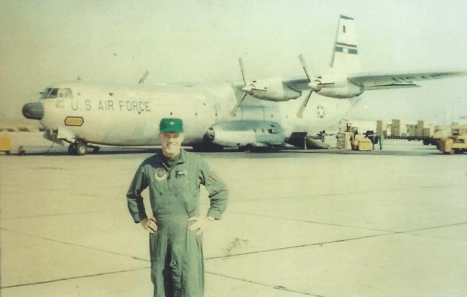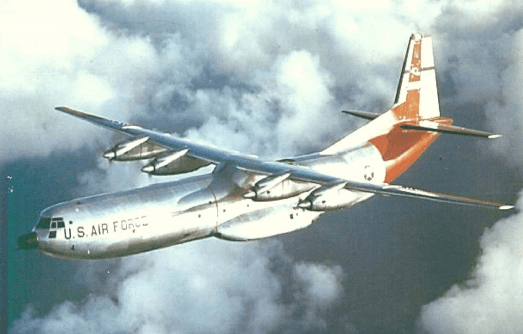
 A Minnesota PBS Initiative
A Minnesota PBS Initiative
I spent five years (1965-1970) flying the Douglas C-133 Cargo master on combat support missions to South Vietnam, generating 169 combat flight hours. My standard routing on these missions was Dover, AFB, DL, Travis AFB, CA, Hickam, AFB, Hawaii, Wake and Guam Island and Kadena Air Base, Okinawa. (After landing In Kadena, I would visit the base barbershop for a haircut, shave, shampoo, manicure and boot shine. The barber and manicurist would be young Japanese females while the shoeshine boy would be a Japanese male. The entire cost would be one dollar and tipping was not recommended).

Lou Martin next to C-133 he flew to South Vietnam.
On one of these missions, after delivering about fifty thousand pounds of cargo to the Tan Son Nhut Airport in Saigon I was told that my return load to the US would be a battle-damaged F-4 jet fighter. We lowered the rear cargo ramp, allowing aerial port personnel to load the disabled jet, which was in three wooden dollies. I asked the Air Force sergeant in charge if the jet was purged of all fuel. His response, “Absolutely, colonel,” pointing to bright yellow tags hanging from the F-4 stating, “Purged of all Fuel.”
I departed the Saigon Airport around sunset and took up a heading for Clark Air Base, four hours to the east. The empty F-4 weighed only 30,000 lbs., so my initial level-off altitude was 21,000 feet. As I approached the East Coast of South Vietnam I could see numerous lightning flashes over the South China Sea, but they seemed widely dispersed so by employing airborne weather avoidance radar I thought I would have no problem in steering around them. However, by the time we were climbing through 19,000 feet, the night sky was embedded with violent thunderstorms and I was picking my way through towering cumulus clouds and flashes of lightning, when suddenly, my cockpit radar screen gave off with a bright flash and went blank. I was now forced to avoid the worst of the storms by manually steering around the brightest lightning flashes.
I told my crew, “Tighten your safety belts and hang-on” as we leveled off at 21,000 feet. About this time we detected the pungent odor of jet fuel so my reserve flight engineer, holding on to the sides of the bulkheads to steady him from the turbulence, headed for the cargo compartment to investigate. A few seconds later I received the following call on the inter phone, “Colonel, we have a real problem. Fuel is spewing out from that F-4 and there is about one quarter inch of JP-4 covering the cargo compartment floor and sloshing back and forth from the turbulence.”
One spark and we would disappear in one big bright flash over the South China Sea and the Air Force would be faced with another C-133 mysteriously disappearing.
This was not good news! We were picking our way through numerous thunderstorms, our airborne radar was inoperative, and the cargo area, being a sealed compartment, was awash with explosive jet fuel. One spark and we would disappear in one big bright flash over the South China Sea and the Air Force would be faced with another C-133 mysteriously disappearing. A subliminal thought ran through my mind that if we blew-up, it would be back to “square one” in investigating the previous mysterious C-133 crashes and I would not be around to tell them what really happened.

I told my copilot to take over control of the aircraft, do his best in avoiding the thunderstorms and start an immediate descent to 10,000 feet. I then instructed the flight engineer to regulate the cabin pressure altitude, which was now around 8,000 feet, to as low a setting as possible because the higher cabin altitude was obviously causing the residue fuel in the F-4 to be ejected from unsealed fuel lines. (It was apparent that I had been lied to regarding the jet being purged of all fuel, but that was not my immediate concern).
It was imperative that we descend to a lower altitude, get rid of the fuel sloshing around in the cargo compartment, avoid the use of electrical components (which might generate a spark) and pray we are not hit by lightning! (I was sure the Pilot’s Grim Reaper was behind this entire episode and was eagerly monitoring its outcome).
My copilot asked if he should obtain ATC clearance before descending but I told him no, “we do not want to key the high frequency radio or actuate anything, including opening the rear cargo ramp, which may cause a spark.” With that, my navigator and I grabbed oxygen masks, plugged them into walk-around bottles and headed for the cargo compartment.
After descending the cockpit stairs, I was shocked, and somewhat frightened, by the scene that unfolded before me. Jet fuel was spewing out from several open fuel lines in the folded wings and fuselage of the jet, and the cargo compartment floor was flooded with highly volatile fuel, swishing back and forth in tune with the rocking aircraft. To add more drama to the potential explosive scene lightning flashes could be seen through the small round windows lining both sides of the cargo compartment.
My loadmaster, and extra flight engineer, were wearing oxygen masks plugged into portable oxygen bottles and busily soaking up the spilt fuel. The loadmaster was sweeping puddles of it into pools so they could soak it up with the use of a large deck mop. When the mop could hold no more, they squeezed its contents into a bucket with a foot-activated wringer. I admired their sterling effort, but it appeared that they were just keeping pace with the amount of fuel pouring out from the F-4.
I felt that the situation was so critical that the smallest spark would ignite the whole mess. I returned to the cockpit while my navigator remained in the cargo compartment to assist in sweeping the fuel into pools. I told my copilot to reduce the engine power to idle, assume a nose high attitude and increase the rate of descent. (I wanted the aircraft to assume a high angle of attack to force the fuel to flow toward the rear of the aircraft).
I returned to the cargo compartment and was pleased to note that the amount of fuel spewing out from the jet was now just a trickle. In addition, the nose high attitude had forced the spilled fuel to pool in the rear of the cargo compartment. (I now thought we had a chance of solving the problem before the Pilot’s Grim Reaper could find a way of blowing us up).
When a bucket was full, I would carry it up the slanted rear cargo ramp and dump it out one of the open pressurization outflow valves. With our eyes and feet burning, from the effects of the fuel, we continued this process until all the fuel that could be soaked up was dumped overboard and fuel was no longer being ejected from the F-4 jet.
We congratulated each other for still being alive and headed for the cockpit where we would be able to breathe without the use of an oxygen mask. When back in the cockpit I noted that we were now flying at 10,000 feet in smooth air, with a cabin pressure altitude of zero and the line of thunderstorms many miles to the rear. It appeared that we would survive. However, my boots were soaked with jet fuel so I took them off to let my feet dry out. My crew members that assisted in the cargo compartment clean up did the same. My copilot asked if we should inform ATC with our high frequency radio that we were flying at such a low altitude, but were otherwise OK. I said, “No, the cargo compartment is still not fully dried out and still reeked of fuel fumes and I don’t want to take a chance on the radios creating a spark, as fuel vapors are more dangerous than liquid fuel.” Therefore, we just kept on flying toward Clark AFB and would contact them when we were within VHF radio range.
Fortunately, we had departed Saigon with excess amounts of fuel so remaining at 10,000 feet was not a fuel-burn problem. When about 75 miles from Clark, I called the control tower on VHF. They were surprised to hear from us, as they had not received any updates on our flight since shortly after we departed Saigon and had reported us missing and presumed lost. They were also surprised to learn that we were flying at 10,000 feet. I told them that I would explain everything after landing.
We made an uneventful night landing and after shutting down the engines, a maintenance officer came to the cockpit and said, “Colonel, I think you have a fuel leak. I can smell fuel fumes in the cargo compartment”. My answer, “No kidding, I guess we will have to check it out.”
I demanded that the F-4 be off loaded and stated that I was not carrying it any further. I submitted a report of the incident, outlining how close we had been to becoming another C-133 accident statistic, but never received a reply. (I accepted the incident as the perils of war, and let it go at that). We opened the side cargo door and the rear cargo ramp and left them open for 24 hours. The following day, with our radar problem corrected and the fuel fumes evaporated, we departed Clark AFB and three days later were safe and sound in Dover, AFB Delaware.
The above is an excerpt from Lou Martin’s book, “Close Encounters with the Pilot’s Grim Reaper”.
Story Themes: Books, Clark AFB, Clark Air Force Base, Close Call, Douglass C-133, F-4 Jet Fighter, Tan Son Nhut Airport, Terrain, Weather